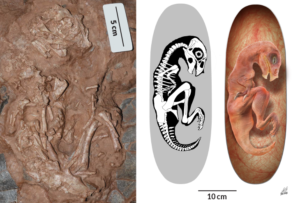
Dinosaurs may be extinct, but our fascination with them is alive and well! There seems to be a never-ending stream of new fossil discoveries around the globe, often leading to new species being named. It’s an exciting time to be an archaeologist, paleontologist, or just a “plain” dinosaur lover!
Read on for some interesting news reports related to dinosaurs and fossils. Let us know if you find an article you’d like us to post!
The Fascinating Case of Baby Louie
Dinosaurs might live on today as birds, but they hatched like reptiles. As this Science News article explains, a dinosaur embryo skeleton dubbed “Baby Louie” was discovered in China in the 1990s. In 2015, a team of Chinese paleontologists returned to the site where the eggs were excavated. They analyzed the fossils and did extensive testing on Baby Louie. Now the team has figured out who Baby Louie’s ancestors were. It belongs to a newly identified species of dinosaur called Beibeilong sinensis, researchers reported in May 2017 in Sci News. In Chinese, Beibei means “baby” and long means “dragon.”
For even more on dinosaur eggs, check out “Baby Dinosaurs Took Three to Six Months to Hatch.”

A famous dinosaur fossil embryo called Baby Louie is shown at left atop of the eggs it was found with. The drawings at right show how the skeleton and embryo curled up inside an egg.
IMAGE SOURCES: H. Pu et al / Nature Communications, 2017 (left); Z. Chuang (right)
Meet Razana
It’s not exactly headline news that alligators and crocodiles are basically living dinosaurs. (Except they aren’t dinosaurs. For one thing, they’re still around, and just as scaly and scary as ever.) But scientists recently put together a set of bones of one of crocodiles’ earliest known ancestors, and it’s just another piece of evidence that modern crocodiles are descendants of prehistoric dinosaurs. Meet Razanandrongobe sakalavae. She’s more than just a pretty face—she’s proof that crocodiles (or more accurately notosuchians, the ancestors of crocodiles) are much older than we previously thought.
This July 2017 article from Curiosity.com offers wonderful details about “Razana.”
- This newly-discovered ancestor of modern crocodiles is 42 million years older than the next oldest specimen.
- Razanandrongobe sakalavae (“Razana” for short) was probably longer than 40 feet, and almost certainly fed on dinosaurs with its T. rex–sized teeth.
- It helps fill in a major gap in the evolutionary history of crocodiles.
- Razana didn’t look a whole lot like modern crocs, but her descendents did. Crocodiles have been basically the same for more than 100 million years.

Paleoartistic restoration of the head of Razanandrongobe sakalavae. Unlike extant crocodilians, this terrestrial predator had a deep skull. IMAGE SOURCE: Fabio Manucci
The Oldest Human Fossils Found

Lower jaw fossil unearthed in Morocco from around 300,000 years ago, come from the oldest known Homo sapiens. IMAGE SOURCE: J.J. Hublin / MPI-EVA, Leipzig
The Velociraptor’s Feathered Cousin
About 71 million years ago, a feathered dinosaur that was too big to fly rambled through parts of North America, likely using its serrated teeth to gobble down meat and veggies, a new 2017 study finds. The newly named paleo-beast is a type of troodontid, a bird-like, bipedal dinosaur that is believe to be a close relation of Velociraptor. Found in Canada, it has been named Albertavenator curriei.

An artist’s interpretation of the newly identified, feathered dinosaur Albertavenator curriei. ILLUSTRATION CREDIT: Oliver Demuth
For more on another feathered cousin of the Velociraptor found in China in 2015, enjoy this article from Live Science.

The preserved skeleton of feathered, short-armed dinosaur, Zhenyuanlong suni. IMAGE CREDIT: Junchang Lü.

